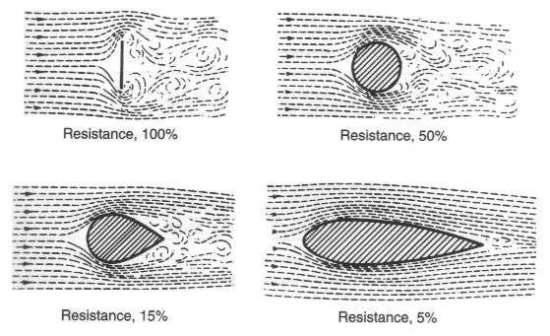Hello jxj and All,
The answer to your question is yes.
The same frontal area can provide different drag resistance depending on shape as we all know.
The trick for the fat person is to grow the fat in the proper shape - perhaps a mold that you sleep in … 
… Remembering that for most bicycle operations aero trumps weight.
Or utilize plastic surgery to get that streamline shape … would that be legal? … is not Tommy John surgery legal?
“Today, tissue expanders are an essential tool for plastic surgeons. … breasts following mastectomies and reconstructing facial features such as lips and eyelids. … Dacron-reinforced Base Provides a Firm Platform for Directional Expansion …”
'With enough time and money we can do it … ’

So where is most advantageous place for this surgical fat streamlining?
The cylindrical shape of the upper arm at right angles to the air flow would be an easy place to start …
As you can see from the diagram above you could reduce the cylinder resistance from 50% to 15% with just a bit of Dacron and fat … although it might not be worth the effort to get to the 5% resistance level when considering the amount of fat and Dacron required. (Of course we will always have people that push the envelope.)
Lower leg calf muscles should experience a nice reduction with this technique also.
The initial cost and biennial maintenance would not be too expensive and … the operation should not prove to risky (except for the possibility of infection and other normal surgical risks - blood clots - stroke - etc.) … for those truly serious about their triathlon or cycling career. This could spawn a new industry for functional body changing rather than just decorative tattooing and nose, belly, nipple, and ear rings.
The benefits might carry over into running and swimming also as upper arm drag is an important drag consideration - especially in swimming.
A preliminary study with glue on devices simulating the fat would yield data to determine the feasibility for various body types. Just as we have bicycle fit clinics with measurement devices … similarly - a wind tunnel and swim flume clinic will provide testing for surgical drag reduction.
Rather than traditional fat the additional space could be used for electronics or created with a substance lighter and firmer than ordinary fat.
Pace makers are implanted - other substances and devices could also be implanted … in an optimum shape.
Will these new ‘Guns’ become a social phenom and everyone want them for status … ?
Cheers,
Neal
+1 mph Faster

